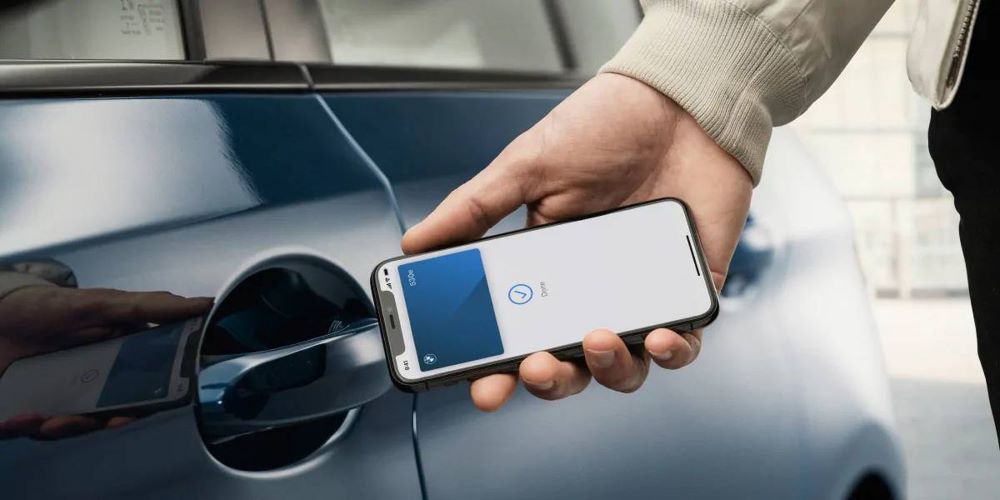
When we were kids, most of us assumed we’d be driving flying cars by the time we were adults. Even though this Jetson’s vision of transportation is still in the somewhat distant future, technology is enabling automakers vehicles that are getting smarter and safer each year.
Car Key Technology
For example, drivers have been using keyless entry and ignitions for over two decades. Most of us can’t even remember the last time we used an actual car key instead of a fob. Until recently, key fobs used either radio frequency identification (RFID), near field communication (NFC), or Bluetooth® to communicate with a car’s computer system.
- RFID – An RFID key fob contains an antenna and a microchip with a unique identifier that a receiver in the car has been programmed to recognize. Using an encrypted RF signal and rolling codes, the fob sends the identifier. If the driver is close enough and the identifier is correct, the receiver in the car will then grant the user access.
- NFC – NFC is often used as a redundant system in case a fob’s battery runs out. When a fob is within a certain distance of the car, the fob “wakes” and communicates with the car to unlock the door.
- Bluetooth – Drivers use Bluetooth technology for smart key or smartphone wireless access when approaching a car. Using data packets and apps, Bluetooth relies on the measurement of signal strength to evaluate the distance of a driver to provide access to the vehicle and other app functionalities like starting the car.
Fighting Relay Attacks
A major issue with using these technologies is they can be tricked. Car hackers can use relay attacks to gain access to vehicles and manipulate the system’s RFID, NFC, or Bluetooth signals.
A relay attack usually involves two hackers – one near the vehicle and the other near the fob – with devices that can communicate with the fob and the car’s computer system. When the car owner presses the unlock button on the key fob, the signal is intercepted near the car and transmitted to the device nearby. The device then signals back to the car and tricks it into thinking the fob is nearby and unlocks the doors.
The next logical stage in the evolution of auto entry and security is to do without a fob altogether and use the newer ultra-wideband (UWB) and UWB-enabled smartphones and smart watches instead. Since most of us don’t go anywhere without our phones, this keyless/fob-less technology keeps things effortless, convenient, and more secure.
Simply put, UWB turns your phone into a car key. Using UWB-enabled smart devices and vehicles, the technology relies on proximity to calculate the distance between the two with a centimeter-level accuracy. The smart key/smartphone locks or unlocks the vehicle when it’s within a certain distance of the vehicle. It also depends on the direction of movement to determine whether it should lock or unlock the car.
Unlike Bluetooth, UWB is based on time not signal strength. So, relay attacks won’t work on UWB since the attack will add latency to the transmission showing that the smart key is far away from the vehicle’s receiver. UWB also can use a Scrambled Time Sequence (STS)—an “encrypted” measure of a timestamp—to prevent attacks and provide more accurate distance measurements.
The Automotive Future Has UWB in It
While this technology may seem to be in the distant future, it’s being implemented now. FiRa® members Qorvo and NXP Semiconductors already provide chipsets to automotive industry leaders for the new generation of UWB-enabled car access systems. Other chip providers like FiRa member STMicroelectronics and others are entering the automotive space as well.
This newly embraced automotive technology isn’t just a fad. In fact, UWB is projected to reach more than 33% of total cars by 2030. Also, according to Research and Markets, the global UWB-based vehicle access control market was valued at $92.6 million in 2022 and is expected to grow at a CAGR of 17.09% to reach $383.1 million by 2031.
Spearheading this movement is the Car Connectivity Consortium® (CCC) and its Digital Key. The CCC is dedicated to bringing together automotive and consumer technology industries to develop industry standards to solutions for the future of vehicle-to-smartphone connectivity. The CCC Digital Key is a standardized ecosystem that enables mobile devices on any operating system to securely store, authenticate, and share Digital Keys for smart vehicles.
In November 2023, FiRa and the CCC formed the Joint Ultra-wideband MAC PHY Working Group (JUMPWG) aimed at developing and maintaining the UWB technology specifications used in the CCC Digital Key. The working group is focused on developing industry standards for solutions to address the future of vehicle-to-smart device connectivity.
“Including UWB in the CCC Digital Key is an essential layer of technology with real-world applications, making it highly convenient for consumers to consistently access their vehicles using their smart devices,” said FiRa Consortium’s Board Chair Clint Chaplin.
Even though we’re not yet driving flying cars, UWB is prompting technology companies and the automotive industry to reach for a future where car connectivity, convenience, security, and innovation aren’t just goals but certainties.